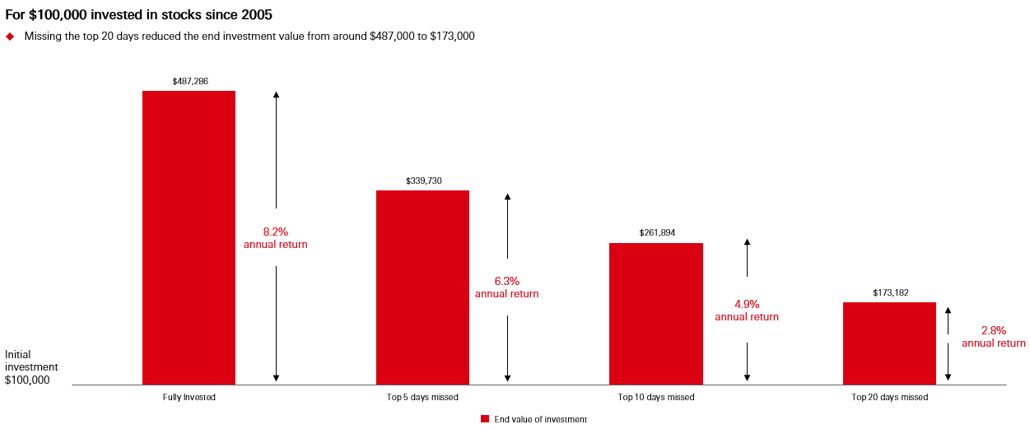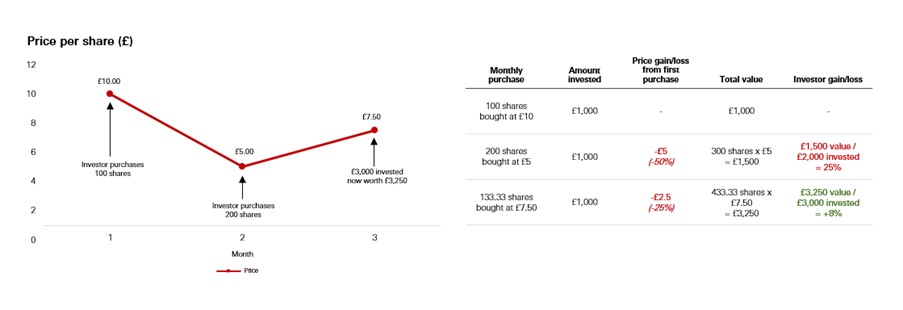
19 Feb 2025
Short-term volatility is part and parcel of the investment journey
Markets can fluctuate depending on the news flow or expectations on valuations and corporate earnings. It is important to remember that volatility is to be expected from time to time in financial markets.
History does not necessarily repeat itself, but it does rhyme. Short-term volatility can occur at any time, but they do not necessarily derail the long-term growth in stock markets. Historically, significant recoveries occur following major setbacks including economic downturns and geopolitical events (Chart 1).
While headline-grabbing news can affect short-term market sentiment and lead to reductions in asset valuations, share prices should ultimately be driven by fundamentals over the long run. Therefore, investors should avoid panic selling during volatile periods, to avoid missing out on any potential market recovery.

Past performance is no guarantee of future returns.
Source: Bloomberg, HSBC Asset Management as at 31 December 2024. MSCI ACWI Net Return index.
When markets get rocky, it is tempting to exit the market to avoid further losses. However, those who focus on short-term market volatility may end up buying high and selling low. History has shown that financial markets go up in the long run despite short-term fluctuations. Though markets do not always follow the same recovery paths, periods after corrections are often critical times to be exposed to the markets. Staying invested for longer periods tends to offer higher return potential.
For example, the 1-year bar chart (far left) shows that performance of global equities over any 1-year period between 1999 and 2024 ranged between -51% and 79%. For any 10-year period, returns ranged between -23% and 273%. The diversified approach is the only one that generated positive returns over any 10-year period!

Currency: USD. Source: Bloomberg, HSBC Asset Management, as at 31 December 2024. Indices used: Equities – MSCI AC World Total Return Index. Bonds – Bloomberg Global-Aggregate Total Return Index Value Unhedged USD. 'Diversified’ is a representative, balanced asset allocation across global equities, bonds and alternatives. Bond indices are hedged. Equities are unhedged. Past performance is no guarantee of future returns.
Diversification means investing in various asset classes at the same time, allowing your investment to be less exposed to large fluctuations. Different asset classes often perform differently under various market conditions
In the graph below you can see that in any given time period, market conditions can mean a single asset class can be top performing in one year, and lowest performing in the next. By combining assets with different characteristics, the risks and performance of different investments are combined, thus lowering overall portfolio risk. That means, a lower return in one type of asset may be compensated by a gain in another.

Source: Morningstar, HSBC Asset Management, data to December 2024. All returns in USD, total return. Indices used: DM Equities: MSCI World Index; EM Equities: MSCI Emerging Market Equity; EMD Local currency: Bloomberg EM Local Currency Government Diversified; EMD Hard currency: ICE Bank of America Merrill Lynch Emerging Market Bond Index; Global Corporate Bond: Bloomberg Barclays Global Aggregate Corporate Bond Index; Global High Yield Bond: ICE Bank of America Merrill Lynch Global High Yield; Global Government Bond: FTSE World Government Bond Index; Property: FTSE EPPRA/NAREIT Developed Property Index; Cash: ICE LIBOR 3 Month; Diversified: 'Diversified' performance was calculated using a representative, moderate-risk asset allocation to all of the stated indices. Bond indices are hedged. Equities are unhedged. Past performance is no guarantee of future returns.
Don’t be passive in the face of market declines. When market sentiment is low, valuations tend to be driven down which provides investment opportunities. In rising markets, people tend to invest as they chase returns, while in declining markets people tend to sell. When investors overreact to market conditions, they may miss out on some of the best-performing days.
Though no one can predict market movements, the times when ‘everyone’ is overwhelmingly negative often turns out to be the best times to invest.

Source: Bloomberg, HSBC Asset Management. Returns are for developed market stocks - MSCI World Daily Total Return Gross World Index, as at 31 December 2024. Past performance is no guarantee of future performance.
Investing regularly means continuous investment regardless of what is happening in the markets. When investors make fixed regular investments, they buy more units when prices are low and less when prices are high. This will smooth out the investment journey and average out the price at which units are bought, thus reducing the risk of investing a lump sum at the wrong time, particularly amid market volatility. The longer the time frame for investment the better, because it allows more time for investments to grow via the compounding effect.
Even though the investor buys £1,000 worth of shares at both a price of £10 and £5 per share, the outcome is a gain. This is because investing a fixed pounds amount means buying double the number of shares at the lower £5 price versus the original amount purchased at £10.

Source: HSBC Asset Management. For illustrative purposes only and does not relate to any investments. The figures are purely hypothetical. Past performance is no guarantee of future returns.





We’re not trying to sell you any products or services, we’re just sharing information. This information isn’t tailored for you. It’s important you consider a range of factors when making investment decisions, and if you need help, speak to a financial adviser.
As with all investments, historical data shouldn’t be taken as an indication of future performance. We can’t be held responsible for any financial decisions you make because of this information. Investing comes with risks, and there’s a chance you might not get back as much as you put in.
This document provides you with information about markets or economic events. We use publicly available information, which we believe is reliable but we haven’t verified the information so we can’t guarantee its accuracy.
This document belongs to HSBC. You shouldn’t copy, store or share any information in it unless you have written permission from us.
We’ll never share this document in a country where it’s illegal. This document is prepared by, or on behalf of, HSBC UK Bank Plc, which is owned by HSBC Holdings plc. HSBC’s corporate address is 1 Centenary Square, Birmingham BI IHQ United Kingdom. HSBC UK is governed by the laws of England and Wales. We’re authorised by the Prudential Regulation Authority (PRA) and regulated by the Financial Conduct Authority (FCA) and the PRA. Our firm reference number is 765112 and our company registration number is 9928412.